ROMMEL THREATENS BRITISH ARMY IN LIBYA
Near Tobruk, Libya, North Africa · May 26, 1942
The yearlong Desert War in the wasteland of Western Egypt and Eastern Libya had reached a stalemate in May 1942, with both Allied and Axis sides licking their wounds. The fighting started four days after Benito Mussolini’s Italy declared war on Great Britain and France in June 1940. Egyptian-based British forces crossed into Libya, where the Italians had been a presence since 1911–1912, and captured a fort just over the border. This was followed by the Italian Tenth Army penetrating 60 miles into Egypt and capturing a Bedouin camp that September.
Operation Compass (December 9, 1940, to February 9, 1941), a British Commonwealth counteroffensive, put an end to the adventurous Tenth Army. Mussolini’s Axis partner, Adolf Hitler, dispatched the German Afrika Korps under Lt. Gen. Erwin Rommel to Libya to prevent a complete Italian meltdown.
On this date in 1942 “The Desert Fox,” Rommel’s nickname in the British media, led his Afrika Korps in assaulting the Allies’ Gazala Line east of Tobruk in Eastern Libya. One month later, on June 20–21, 1942, Tobruk was Rommel’s, along with 33,000 British and Commonwealth prisoners. Egypt and the Suez Canal—Britain’s watery link to India and its Southeast Asian colonies of Burma, Malaya, and Singapore—appeared up for grabs, and passage to the Middle Eastern oil fields—vital to both sides—appeared open, too.
Tobruk was the British Eight Army’s worst defeat. Not long afterwards, British Prime Minister Winston Churchill appointed Lt. Gen. Bernard Law Montgomery to head the Eighth Army. The leadership change, Rommel’s temporary sick leave home, and the addition of more Allied men and equipment (Montgomery would have 40 percent more men and nearly twice as many tanks as had the Germans and Italians) eventually led to a crushing Axis defeat at the Second Battle of El Alamein (October 23 to November 4, 1942), and it marked a major turning point in the Desert War. Axis casualties of 37,000 amounted to over 30 percent of their total force. By comparison Allied casualties of 13,500 were a remarkably small proportion of their total force. On November 10, 1942, Churchill famously summed up the Axis defeat at El Alamein and its import on Allied fortunes with the words, “This is not the end, it is not even the beginning of the end. But it is, perhaps, the end of the beginning.”
[amazon_carousel widget_type=”ASINList” width=”600″ height=”200″ title=”Recommended Reading” market_place=”US” shuffle_products=”False” show_border=”False” asin=”1855329670,0811734137,1841760927,067401376X,0811705919,1849086400,1849085013,1612000967,1468304984,081170419X” /]
The Western Desert Campaign, June 1940–February 1943
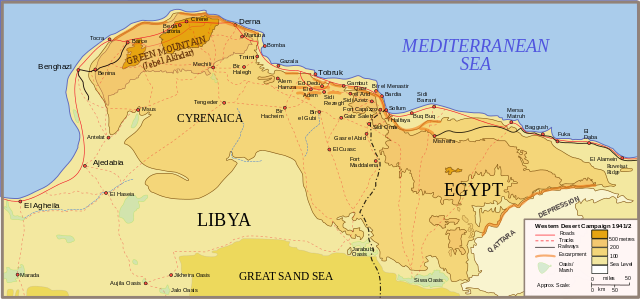 |
Above: Map of Cyrenaica (Eastern Libya) and Western Egypt, 1941. The Western Desert Campaign, also known as the Desert War, took place in this harsh desert area lightly populated with nomadic herdsmen except along the coast, where there were several fortified settlements, one being Tobruk with its deep, natural, and protected harbor (center in map). The seesaw struggle lasted from June 1940 until early February 1943, though Axis forces had shifted into permanent retreat in mid-November 1942.
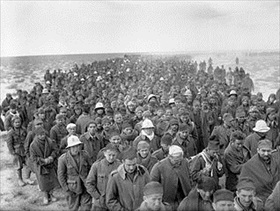 | 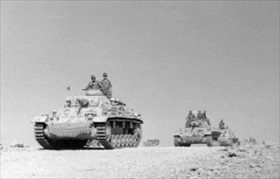 |
Left: A column of Italian prisoners captured during Operation Compass (December 9, 1940 to February 9, 1941) march to a British army base. In two months of combat the British Eighth Army captured nearly the whole of the Italian Tenth Army, taking 130,000 prisoners and almost 400 tanks. When Erwin Rommel arrived in Libya at the head of the German Afrika Korps in February 1941, the Italians had just 7,000 soldiers in Eastern Libya.
![]()
Right: A column of Panzer Mk IIIs of the German Afrika Korps moves up a desert road, March 21, 1941. On March 24 Rommel launched a limited offensive. By early April, after much of the British Army in North Africa had left to support Greece against Mussolini’s invasion of that country, Rommel retook Benghazi, capital of Cyrenaica (Eastern Libya), and pressed on toward Egypt, having secured all of Libya with the exception of the strategically important port of Tobruk by April 15, 1941. Tobruk remained besieged from land, sea, and air until December 1941.
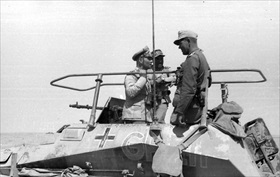 | 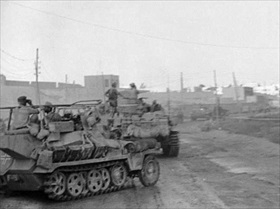 |
Left: Rommel’s second offensive in Eastern Libya against British and Commonwealth troops, nicknamed “The Desert Rats,” took place in May and June 1942. Here Rommel can be seen on the left with his chief of staff, Gen. Fritz Bayerlein (partially hidden), as the two men survey the landscape from Rommel’s command halftrack, which he had named “Greif” (Griffin). Both adversarial armies used the 240‑mile‑wide Western Desert of Western Egypt and Eastern Libya as a testing ground in terms of organization, equipment, and methods of waging war.
![]()
Right: On June 21, 1942, Tobruk fell to Rommel (perhaps seen here entering Tobruk in “Greif”). Tobruk remained in Axis hands until November 11, 1942, when Lt. Gen. Bernard Montgomery’s Eighth Army retook it after the Second Battle of El Alamein (October 23 to November 11, 1942). El Alamein revived the morale of the British, being the first major offensive against the Germans since the start of the European war in 1939 in which the West had achieved a decisive victory. Tobruk remained in Allied hands thereafter. In May 1943 the remnants of the Axis forces surrendered to the Allies from their enclave in Tunisia.
Generals at War: Rommel vs. Montgomery and the Second Battle of El Alamein, 1942
![]()

 History buffs, there is good news! The Daily Chronicles of World War II is now available as an ebook for $4.99 on Amazon.com. Containing a year’s worth of dated entries from this website, the ebook brings the story of this tumultuous era to life in a compelling, authoritative, and succinct manner. Featuring inventive navigation aids, the ebook enables readers to instantly move forward or backward by month and date to different dated entries. Simple and elegant! Click
History buffs, there is good news! The Daily Chronicles of World War II is now available as an ebook for $4.99 on Amazon.com. Containing a year’s worth of dated entries from this website, the ebook brings the story of this tumultuous era to life in a compelling, authoritative, and succinct manner. Featuring inventive navigation aids, the ebook enables readers to instantly move forward or backward by month and date to different dated entries. Simple and elegant! Click 











